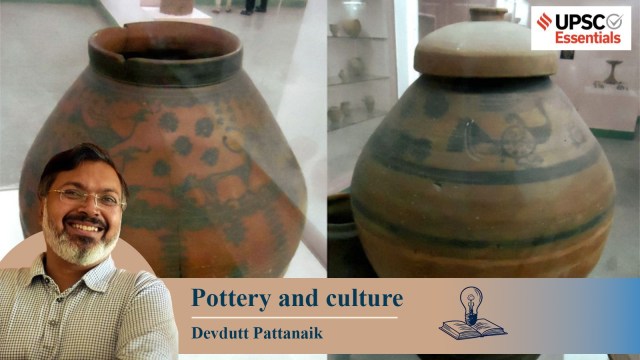© IE Online Media Services Pvt Ltd
Latest Comment
Post Comment
Read Comments
 Painted pottery urns from Harappa (Cemetery H culture, c. 1900-1300 BCE) (National Museum, New Delhi). (Image source: Wikimedia Commons)
Painted pottery urns from Harappa (Cemetery H culture, c. 1900-1300 BCE) (National Museum, New Delhi). (Image source: Wikimedia Commons)(The Indian Express has launched a new series of articles for UPSC aspirants written by seasoned writers and scholars on issues and concepts spanning History, Polity, International Relations, Art, Culture and Heritage, Environment, Geography, Science and Technology, and so on. Read and reflect with subject experts and boost your chance of cracking the much-coveted UPSC CSE. In the following article, Devdutt Pattanaik, a renowned writer who specialises in mythology and culture, explains how pots are essential to understanding culture.)
Pottery is a sign of culture. It allowed humans to transport food and water. Besides cooking or storage — it serves ritualistic purposes in both marriage and death ceremonies. This dual function, both practical and spiritual, makes pottery an essential aspect of cultural heritage.
India is famous for its lota, which is different from the Middle Eastern surahi and the Greek amphora. A lota has a rim at the mouth, a neck, and a globular body, like a lotus bud. This is distinct from the surahi that lacks a rim, has a long neck, and a linear orientation, similar to a lily bud. Lota usually has a round base, which allows it to be easily placed in soft mud, or a flat base.
The surahi also can have a sharp conical base that allows it to be perched between planks of wood on a ship or buried in sand to stand upright. The lota and the surahi can have a snout on the side. Amphora has two handles on either side. A lota, however, does not need handles, as it can be easily held by the neck.
Pottery in India is not just about storing water or milk — it also holds religious and cultural significance. Pots have been used to represent deities and play a role in rituals. They are often filled with sacred items such as coconuts, bananas, mango leaves, and flowers.
Even today, during religious ceremonies and temple rituals, pots are placed to symbolise auspiciousness and the presence of the divine. This practice dates back thousands of years. Kashmiri Pandit rituals use large pots with narrow mouths to represent Shiva, Shakti and Bhairava. These pots are filled with offerings to the gods.
In Buddhist stupas and temples, we also find the Purna Kumbha – a pot overflowing with fertility and life. Plants, flowers, and fruits are depicted bursting from it, symbolising abundance — similar to the concept of the Horn of Plenty or the Akshay Patra. The Amrit Kumbha, or the pot of nectar, is another significant representation in Indian culture.
In Hindu traditions, pottery plays a vital role in death rituals. Fire from the kitchen is carried in a pot to light the funeral pyre. Water pots are broken during the Hindu funeral ceremony before the pyre is lit. Bones and ashes of the deceased are collected in a pot, which is hung outside the house, until it is time to immerse the remains in the river. In early Vedic times, these pots containing bones would simply be buried in the ground.
During prehistoric times, pots were also used in burial rituals. In Inamgaon, Maharashtra, a pot from the Megalithic period (Iron Age, c. 1000 BCE) was found containing a human skeleton. In Tamil Sangam poetry, a widow asks a potter to make her a pot large enough for her deceased husband.
The oldest pottery in India dates back to the Harappan Civilisation. Prehistoric pottery was handmade, as the potter’s wheel was introduced later. These early pots were often red with black painted designs of peacocks, buffaloes, pipal trees, neem trees and geometrical patterns like intersecting lines and circles.
Some scholars argue that red and black pottery found in South India suggests a possible migration of people from the Harappan zone (3500 years ago) to the Tamil region (2000 years ago).
A major shift in pottery styles occurred during the Vedic period (c. 1000 BCE – 500 BCE). This era saw the emergence of painted grey ware — grey pots decorated with black lines. These pots have been found in the Gangetic region, in places associated with events from the Mahabharata and the Ramayana.
Later, following the rise of Buddhism and Jainism, and the emergence of urban centres during the Mahajanapada period, another distinct type of pottery emerged — northern black polished ware. This fine black pottery (500 BC to 200 BC) was linked to increasing mercantile activities and trade.
The next significant development in pottery came with glazed porcelain, which arrived in India around 1000 AD from China. Trade with China expanded via both land and sea routes. The land route passed through Central Asia, Persia, and Turkey, while the maritime route connected southern China with India’s coastal regions through Vietnam and Indonesia. When Muslim traders arrived in India, they brought glazed porcelain, commonly referred to as “China ware’’.
What is Painted Grey Ware, and how is it characterised? How is it connected to events from the Mahabharata and the Ramayana?
Discuss the symbolic meaning of the Purna Kumbha in Buddhist stupas and temples?
What major shift in pottery styles occurred during the Vedic period?
The introduction of glazed porcelain influenced Indian pottery traditions. Comment.
What role do pots play in maintaining cultural traditions and religious practices in India?
(Devdutt Pattanaik is a renowned mythologist who writes on art, culture and heritage.)
Share your thoughts and ideas on UPSC Special articles with ashiya.parveen@indianexpress.com.
Subscribe to our UPSC newsletter and stay updated with the news cues from the past week.
Stay updated with the latest UPSC articles by joining our Telegram channel – IndianExpress UPSC Hub, and follow us on Instagram and X.

Read UPSC Magazine